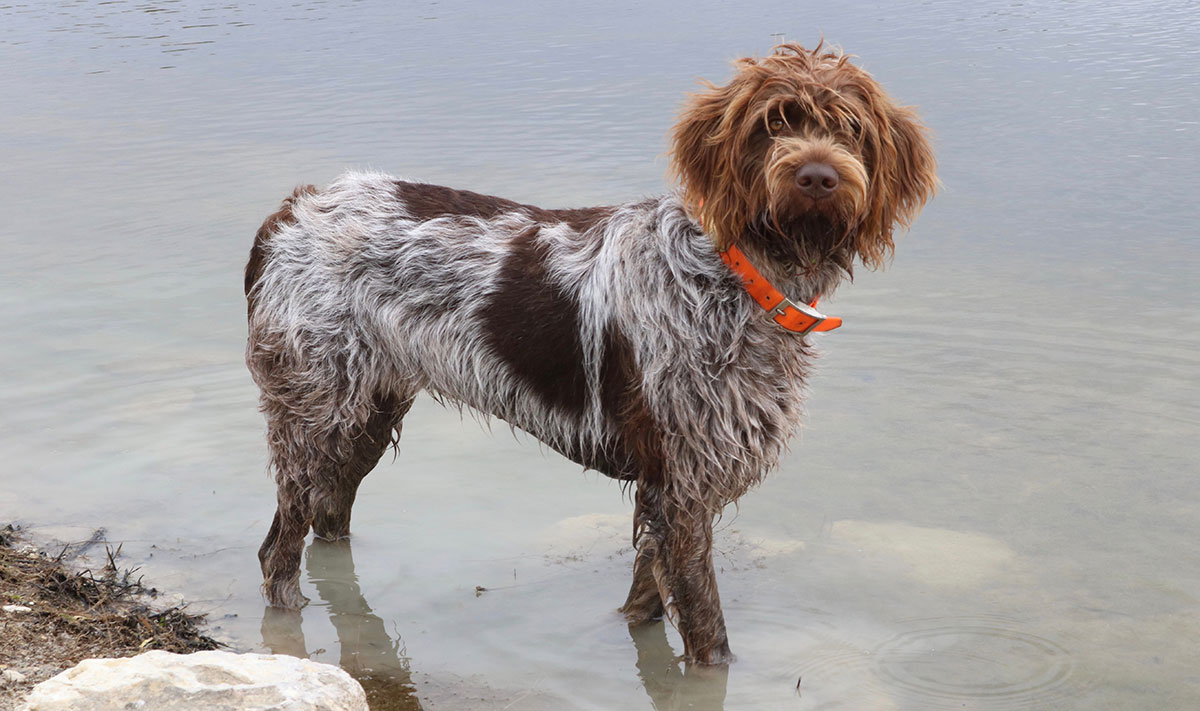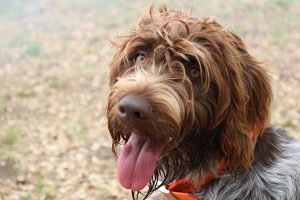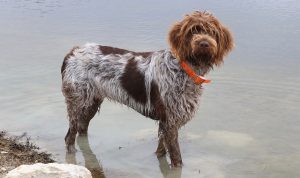
Korthals Griffon – Gundog

Image: Cat Simpson/Shutterstock.com
| Name | Korthals Griffon - Gundog |
|---|---|
| Size | Medium |
| Grooming | Medium |
| Training | Easy to Moderate |
| Exercise | Daily / 1 hour+ play |
| Origins | Holland Germany France |
Korthals Griffon or Should We Say Wirehaired Pointing Griffon?
Or even Griffon d'arrêt à poil dur Korthals for our French & French Canadian friends - Confused? Well, wait till you read about its origin; there are three countries in contention for that honour.
Ok, so what do we know? Well, they are pretty rare outside of mainland Europe, despite being recognised by both the UK Kennel Club and the AKC, and they excel as gundogs, especially around water, thanks to their thick wiry coats. However, they are equally at home being loving family pets - if you have plenty of space that is and enjoy long walks.
They are gentle, friendly, if somewhat sensitive, are good with children and tolerant towards other dogs. What's not to like? Anyway, providing you are not living in a city centre apartment or any flat for that matter, like big affectionate dogs, are quite outdoorsy yourself and are patient enough to wait for a puppy (or have the time to check out the rescue centres) then this could be your ideal dog!
Read on and let's see if we can convince you further...

Korthals Griffon'Ssare quite at home in the water
Image: Cat Simpson/Shutterstock.com
Quick Overview
Name: Korthals Griffon - Gundog Breed (UK Kennel Club)
Size: 20-24 inches (51-61 cm) tall fully grown
Weight: 50-60 lbs 23-27 kg
Grooming: Wirehaired with a soft undercoat so expect to spend a bit of quality time on this.
Training: Easy they are intelligent and eager to please. Responds well to a gentle style.
Exercise: Lots of walks and plenty of play - throwing the ball is good arm exercise.
Temperament: Loyal and Intelligent. Loves company.
Origins: Netherlands, Germany, France depending on who you believe!
Lifespan: 12-15 years
Colourwise they are normally steel grey with brown markings although they are sometimes chestnut brown, white and brown, or white and orange-brown. They do shed a bit thanks to their dense undercoat and can be prone to drooling - but hey no dog is perfect.
Origins
The Korthals Griffon is one of the more recent of the pedigree breeds having been first conceived by Eduard Karel Korthals in 1873, a Dutch national who was living in France at the time but had his main kennels in Germany! Now you can see where the confusion comes from.
Origin country apart we do know that the breed originated from a single bitch called "Mouche" and the aim which he has largely succeeded in was to breed the ultimate hunting dog. Whether they deserve the Heinekin award is debatable however they are very good gundogs and of course fulfil his other desired traits of being resilient and devoted to their owners.
In 1887 they were recognised by the American Kennel Club (AKC) and by the turn of the century there were a number of internationally recognised clubs devoted to the breed.
A Few Facts About The Korthals Griffon!
We wouldn’t be Five Minutes Spare if we didn’t throw some interesting facts your way. Here are some of our favourite little snippets of information regarding them:
- The Original dog recognised by the AKC in 1887 "Zolette" was actually recorded as a Russian Setter (Griffon). The breed was not properly registered until 1916 as Wirehaired Pointing Griffon's.
- All Korthals Griffon's have brown noses - if it is not brown its not a Korthals!
- A well-groomed one should have eyebrows and a moustache.
- Korthals Griffon are not really “barky dogs” if they do then there is usually a good reason, hence they make good watchdogs (but not guard dogs).
Temperament.
They seem to love everybody and really need lots of human company to be happy. They are also high energy hence they are not well suited to apartment living or for families who are out all day. Think a large garden or yard for them to run around in when you are not there as the minimum requirement.
They also get on well with other dogs and other animals that form part of the family group. However, expect them to chase wildlife or neighbourhood cats if given the chance.
They seem to have an affinity with children but despite this adult supervision when with very young children is a must. Not because they are likely to bite but being boisterous knocking them over is almost inevitable.
Training and Maintenance
Some form of obedience training from puppy stage is recommended and given they are intelligent dogs they seem to enjoy this. Once they have learned the basics taking them to canine sporting activities where they can display their natural leanings in a controlled environment will be rewarding for both parties.
Maintenance wise Korthals Griffon's need to be brushed thoroughly once or twice weekly to keep their coats in good condition. Shedding takes place throughout the year to some degree but gets more noticeable during the Spring and Autumn months so think at least twice a week when this happens.
They are also prone to drooling so cleaning their teeth fairly regularly is advisable and it's also important to check the dog's ears on a regular basis and to clean them when necessary. They are quite prone to ear infections, however, the risk can be reduced significantly with good ear cleaning and wax removal. If you are not comfortable doing this take them to a groomer or veterinary practice.
They will need stripping a couple of times a year too so you could combine the ear checks with this. So as you can see these are not low maintenance dogs but as we have said none are perfect.
Common Health Concerns
Like many other breeds, the Korthals Griffon is known to suffer from a few hereditary health issues which are worth knowing about if you are planning to share your home with one of these active and good-looking dogs. The conditions that seem to affect the breed the most include the following:
- Hip Dysplasia- Breeders should have stud dogs hip scored through the BVA/KC hip dysplasia scheme
- Elbow Dysplasia- Breeders should have stud dogs tested through the BVA/KC elbow scheme
- Luxating Patella or trick knee which affects the back legs. This can require surgery is extreme cases.
- Bloat - gastric torsion
Weight gain and obesity is an issue, with Korthals often gaining weight after they have been spayed or neutered. If yours starts to put on weight, adjust their food intake accordingly and or up their daily exercise. They are more prone to gaining weight as they age and although it is tempting to go easy on your old friend you are doing them no favours as obesity can knock several years off their lives. Plus they love exercise and play anyway.
Where to buy Puppy?
Always buy from a registered breeder who can not only show you at least one of the parents, but also give you details of any hereditary issues. Sadly Griffons are often purchased by novice dog owners who are soon overwhelmed by the slightly higher maintenance needs of the breed. There are therefore lots in need of adoption and or fostering so checking the local rescue centres would be a nice thing to do.
Five Minutes Spare
We have numerous other dog articles over on the Five Minutes Spare pages for those that love them as much as we do so please continue to browse or sign up to join our growing community.